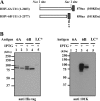Development of a human herpesvirus 6 species-specific immunoblotting assay
- PMID: 22278837
- PMCID: PMC3318559
- DOI: 10.1128/JCM.05834-11
Development of a human herpesvirus 6 species-specific immunoblotting assay
Abstract
In order to assess the full spectrum of human herpesvirus 6A (HHV-6A)- and HHV-6B-associated diseases, we sought to develop an HHV-6 species-specific serological assay based on immunoblot analysis. The immunodominant proteins encoded by open reading frame U11, p100 for HHV-6A (strain U1102) and 101K for HHV-6B (strain Z29), were selected to generate virus species-specific antigens. Recombinant p100 and 101K were produced in a prokaryotic expression system. The expression of these proteins was confirmed by using anti-His tag and 101K-specific monoclonal antibodies. HHV-6 species-specific antibodies were detected by immunoblotting in patient sera. Eighty-seven serum samples obtained from various subjects were utilized to determine the reliability of the method for clinical use. Ten of twelve exanthem subitum convalescent-phase sera reacted exclusively with 101K, whereas none of twelve acute-phase sera reacted with either protein. Two of three sera collected from HHV-6A-infected patients reacted with p100 and 101K. Although all five acute and convalescent-phase sera obtained from transplant recipients reacted exclusively with 101K, two of six convalescent-phase sera obtained from patients with drug-induced hypersensitivity syndrome reacted with both p100 and 101K. Of 38 sera obtained from healthy adults, 31 were positive for 101K antibody, while 4 reacted with both proteins. However, PCR analysis of peripheral blood mononuclear cells and saliva from these subjects did not detect HHV-6A DNA. In conclusion, this novel serological assay based on immunoblot analysis using recombinant HHV-6A p100 and HHV-6B 101K allowed us to discriminate between HHV-6A- and HHV-6B-specific antibodies.
Figures


Similar articles
-
A strongly immunoreactive virion protein of human herpesvirus 6 variant B strain Z29: identification and characterization of the gene and mapping of a variant-specific monoclonal antibody reactive epitope.Virology. 1993 Aug;195(2):521-31. doi: 10.1006/viro.1993.1403. Virology. 1993. PMID: 7687803
-
An immunoblot assay for detection of immunoglobulin M antibody to human herpesvirus 6.Clin Diagn Lab Immunol. 2000 Sep;7(5):823-7. doi: 10.1128/CDLI.7.5.823-827.2000. Clin Diagn Lab Immunol. 2000. PMID: 10973462 Free PMC article.
-
Diagnosis of human herpesvirus 6B primary infection by polymerase chain reaction in young children with exanthematic disease.Rev Soc Bras Med Trop. 2011 May-Jun;44(3):306-8. doi: 10.1590/s0037-86822011005000021. Epub 2011 Apr 29. Rev Soc Bras Med Trop. 2011. PMID: 21537797
-
The role of herpesvirus 6A and 6B in multiple sclerosis and epilepsy.Scand J Immunol. 2020 Dec;92(6):e12984. doi: 10.1111/sji.12984. Epub 2020 Oct 23. Scand J Immunol. 2020. PMID: 33037649 Free PMC article. Review.
-
[Human herpesvirus-6 and human herpesvirus-7 (HHV-6, HHV-7)].Uirusu. 2010 Dec;60(2):221-35. doi: 10.2222/jsv.60.221. Uirusu. 2010. PMID: 21488335 Review. Japanese.
Cited by
-
No serological evidence for a role of HHV-6 infection in chronic fatigue syndrome.Am J Transl Res. 2012;4(4):443-51. Epub 2012 Oct 10. Am J Transl Res. 2012. PMID: 23145212 Free PMC article.
-
Roseolovirus-associated encephalitis in immunocompetent and immunocompromised individuals.J Neurovirol. 2017 Feb;23(1):1-19. doi: 10.1007/s13365-016-0473-0. Epub 2016 Aug 18. J Neurovirol. 2017. PMID: 27538995 Free PMC article. Review.
-
Evidence linking HHV-6 with multiple sclerosis: an update.Curr Opin Virol. 2014 Dec;9:127-33. doi: 10.1016/j.coviro.2014.09.016. Epub 2014 Oct 17. Curr Opin Virol. 2014. PMID: 25462444 Free PMC article. Review.
-
Classification of HHV-6A and HHV-6B as distinct viruses.Arch Virol. 2014 May;159(5):863-70. doi: 10.1007/s00705-013-1902-5. Epub 2013 Nov 6. Arch Virol. 2014. PMID: 24193951 Free PMC article. Review.
-
Avian and simian malaria: do they have a cancer connection?Parasitol Res. 2017 Mar;116(3):839-845. doi: 10.1007/s00436-016-5352-3. Epub 2016 Dec 26. Parasitol Res. 2017. PMID: 28019000 Review.
References
-
- Ablashi DV, et al. 1991. Genomic polymorphism, growth properties, and immunologic variations in human herpesvirus-6 isolates. Virology 184:545–552 - PubMed
-
- Bates M, et al. 2009. Predominant human herpesvirus 6 variant A infant infections in an HIV-1 endemic region of sub-Saharan Africa. J. Med. Virol. 81:779–789 - PubMed
Publication types
MeSH terms
Substances
LinkOut - more resources
Full Text Sources

